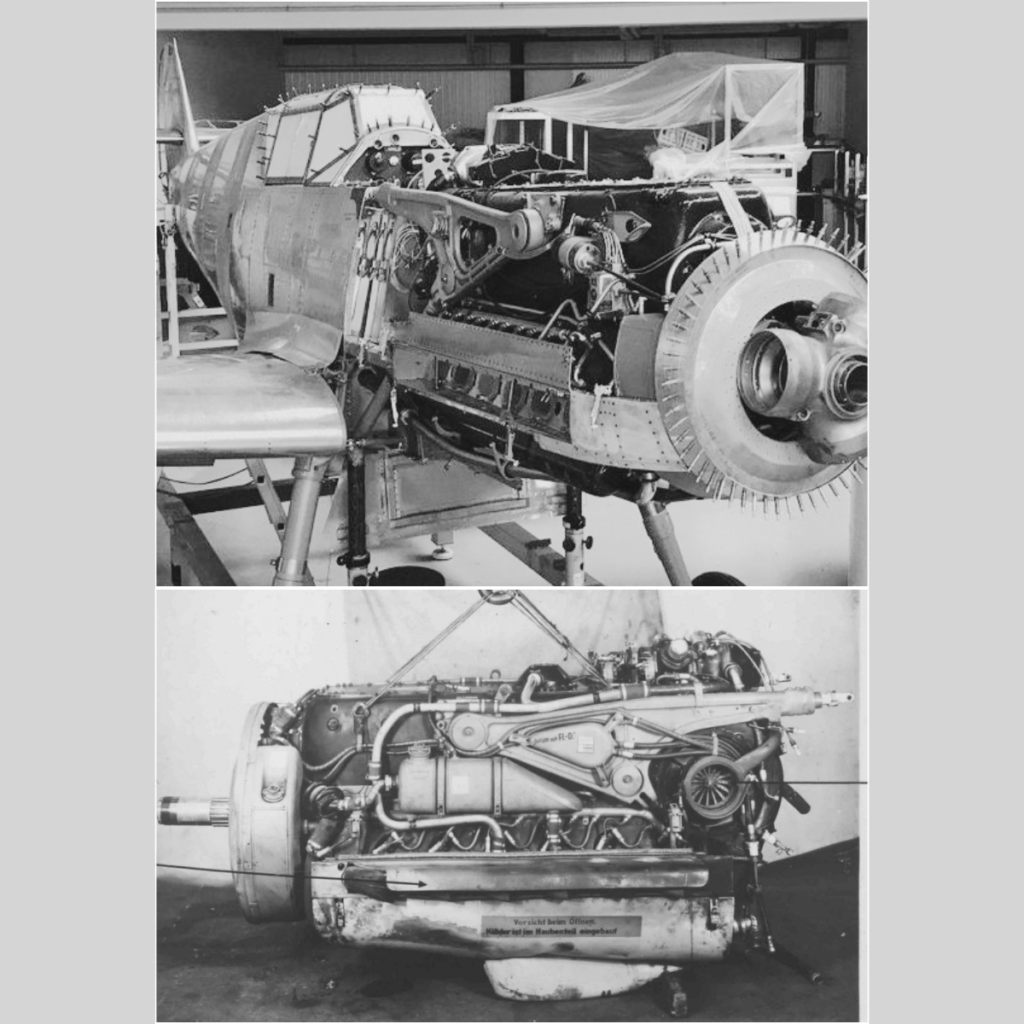
The Daimler-Benz DB 605 is a German aircraft engine, built during World War II. Developed from the DB 601, the DB 605 was used from 1942 to 1945 in the Messerschmitt Bf 109 fighter, and the Bf 110 and Me 210C heavy fighters. The DB 610, a coupled “power system” powerplant comprising a pair of side-by-side configured examples of the DB 605, geared together in the front to turn a single output shaft — and which, like the similar DB 606 that it replaced, weighed 1,515 kg — was used in the A-3 and all A-5 variants of Germany’s only operational heavy bomber, the Heinkel He 177A.

Daimler-Benz DB 605 mounted in a Messerscmitt Bf 109G.
License-built versions of the DB 605 were used in the Macchi C.205, Fiat G.55, Reggiane 2005 and some other Italian aircraft. It was also initially used in the pusher-design Swedish Saab J21. Approximately 42,400 DB 605s of all kinds were built.
Design & Development
The primary differences between the 605 and 601 were greater displacement, higher revolutions, higher compression ratio and a more powerful supercharger. Through careful study the engineers determined that the cylinders could be bored out to a larger diameter without seriously affecting the strength of the existing block. The difference was minimal, increasing from the 601’s 150 mm cylinder bore to the 605’s 154 mm, but this increased the overall displacement from 33.9 litres to 35.7. Altered valve timing increased the inlet period and improved the scavenging to give greater volumetric efficiency at higher speeds, which improved the maximum allowable RPM from 2,600 in the 601 to 2,800 in the 605. The combination of these changes raised power output from 1,350 PS (1,332 hp) to 1,475 PS (1455 hp). The engine was otherwise similar, notably in size, which was identical to the 601. However, its weight did increase from 700 to 756 kg.
In other ways the engine was essentially identical to the 601, being a 12-cylinder, inverted-V (with the crankshaft above the cylinders) design. Both used dual Bosch magnetos firing twin spark plugs for ignition. Fuel injection was powered by a pump supplying up to 90 bar and the oil system used three pumps with a separate 35-litre oil tank. The supercharger was fairly advanced for the era in that it used a barometrically controlled hydraulic clutch (fluid coupling) which allowed the system to automatically compensate for changes in altitude.
One major design difference was the switch from ball bearings to plain bearings which, when combined with increasingly poor grades of lubricants, led to serious problems in service, including engine fires; initially, for example, the use of emergency power was forbidden. Although Daimler-Benz redesigned the bearings and added oil slingers and their associated coolers, the RLM considered the DB 605 to be a “sick engine” and the problems had not been fully resolved by the end of the war.
Like the 601, the 605 was designed to run on “B4” fuel with an octane rating of 87. In 1944 a series of newer engines was introduced, allowing the engine to run on the 100 octane “C3” fuel and optionally including fittings for various optional power-boosting agent dispensing systems, such as the MW50 methanol-water injection system, and GM-1 nitrous oxide injection system. The DB 605AM, running initially on C3 and MW-50, saw power improved to 1,800 PS (1775 hp) for takeoff. In mid-1944, the requirement for C3 was dropped and standard B4 fuel with MW-50 was used. The DB 605AS(M) improved the maximum rated altitude by using a larger supercharger taken from the DB 603 but was otherwise similar to the A(M). The DB 605ASB’s takeoff power was also rated at 1,800 PS (1,775 hp), while maintaining the high-altitude performance of the ASM. The final version of the A-series was the DB 605ASC of 1945, which improved takeoff power to 2,000 PS (1,973 hp).
As early as 1942 Daimler had also been working on an upgraded D-series engine that could run on either C2 or C3 fuel. The first of these, which appeared in late 1944, were a small series of DB 605DM, followed by the main production series, the DB 605DB/DC. These engines were fitted with an adjustable screw stop which allowed the use of either B4 fuel with MW-50, or C-3 fuel without MW-50, in which case the engine was designated DB 605DB, or the use of C-3 fuel with MW-50, in which case the engine was given the -DC suffix instead. In its DB-suffix form the engine generated 1,800 PS (1,775 hp) for take-off at 1.8 ata, while the DC was capable of 2,000 PS (1,973 hp) at 1.98 ata. If MW-50 was not available for use with the B4 fuel the throttle was limited to 1.45 ata for the entire flight. Thus, this series was ideally suited to catering for the chaotic fuel supply situation prevalent during the last months of the Third Reich. These engines were mainly used in the Bf 109G-10 and K-4 series.
Variants
DB 605 AS(M)
Altitude optimized version of 605 A using the larger DB 603 supercharger, up to 1435 PS, ASM with MW-50 system and up to 1800 PS
DB 605 ASB(M)
Altitude optimized late-war version of 605 AS using B4 fuel, ASBM with MW-50 system and up to 1800 PS
DB 605 ASC(M)
Altitude optimized late-war version of 605 AS using C3 fuel, ASCM with MW-50 system and up to 2000 PS
DB 605 B
Same as 605 A but for use in twin-engined aircraft like Messerschmitt Bf 110, Me 210 (different prop/gear ratio)
DB 605 BS
proposed version for twin-engined aircraft, derived from DB 605 AS
DB 605 DB
Improved 605 DM, standard MW-50 equipment, first version up to 1850 PS, later reduced to 1800 PS, B4 fuel
DB 605 DC
Improved 605 DM, standard MW-50 equipment, up to 2000 PS, C3 fuel
DB 605 DM
First DB 605 D version, standard MW-50 equipment, up to 1700 PS
DB 605 E
proposed version for twin-engined aircraft, derived from DB 605 D
DB 605 L
Similar to 605 D but with two-stage supercharger, 2000+ PS
Fiat RA.1050 R.C.58 Tifone
Licence built / developed DB 605A-1 engines, built by Fiat in Italy.
DB 610
Two DB 605 “coupled” (geared together) as a “power system” (71.53L), to work on a single propeller shaft for use in Heinkel He 177, up to 2,909 hp) for take off, 2,750 h) at 2,100 m. Mirror-imaged starboard component engine supercharger.
DB 616
A development of the DB 605.
DB 620
Coupled DB628 engines.
DB 621
A projected two-stage supercharged DB605
DB 625
A turbocharged DB605
DB 628
The DB 605, fitted with a two-stage supercharger, abandoned in March 1944.
Applications
• Fiat G.55 Centauro
• Macchi C.205 Veltro
• Messerschmitt Bf 109G/K
• Messerschmitt Bf 110G
• Messerschmitt Me 210
• Reggiane Re.2005 Sagittario
• Saab 21
• Savoia-Marchetti SM.91
• Savoia-Marchetti SM.92
• Savoia-Marchetti SM.93
• VL Pyörremyrsky





